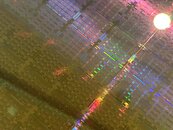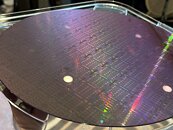- Joined
- Oct 9, 2007
- Messages
- 47,668 (7.43/day)
- Location
- Dublin, Ireland
| System Name | RBMK-1000 |
|---|---|
| Processor | AMD Ryzen 7 5700G |
| Motherboard | Gigabyte B550 AORUS Elite V2 |
| Cooling | DeepCool Gammax L240 V2 |
| Memory | 2x 16GB DDR4-3200 |
| Video Card(s) | Galax RTX 4070 Ti EX |
| Storage | Samsung 990 1TB |
| Display(s) | BenQ 1440p 60 Hz 27-inch |
| Case | Corsair Carbide 100R |
| Audio Device(s) | ASUS SupremeFX S1220A |
| Power Supply | Cooler Master MWE Gold 650W |
| Mouse | ASUS ROG Strix Impact |
| Keyboard | Gamdias Hermes E2 |
| Software | Windows 11 Pro |
Feast your eyes on the first pictures of an Intel "Granite Rapids" Xeon processor wafer, courtesy of Andreas Schilling with HardwareLuxx.de. This is Intel's first commercial silicon built on the new Intel 3 foundry node, which is expected to be the company's final silicon fabrication node to implement FinFET technology; before the company switches to Nanosheets with the next-generation Intel 20A. Intel 3 offers transistor densities and performance competitive to TSMC N3 series, and Samsung 3GA series nodes.
The wafer contains square 30-core tiles, two of which make up a "Granite Rapids-XCC" processor, with CPU core counts going up to 56-core/112-threads (two cores left unused per tile for harvesting). Each of the 30 cores on the tile is a "Redwood Cove" P-core. In comparison, the current "Emerald Rapids" Xeon processor uses "Raptor Cove" cores, and is built on the Intel 7 foundry node. Intel is planning to overcome the CPU core-count deficit to AMD EPYC, including the upcoming EPYC "Turin" Zen 5 processors with their rumored 128-core/256-thread counts, by implementing several on-silicon fixed-function accelerators that speed up popular kinds of server workloads. The "Redwood Cove" core is expected to be Intel's first IA core to implement AVX10 and APX.


View at TechPowerUp Main Site | Source
The wafer contains square 30-core tiles, two of which make up a "Granite Rapids-XCC" processor, with CPU core counts going up to 56-core/112-threads (two cores left unused per tile for harvesting). Each of the 30 cores on the tile is a "Redwood Cove" P-core. In comparison, the current "Emerald Rapids" Xeon processor uses "Raptor Cove" cores, and is built on the Intel 7 foundry node. Intel is planning to overcome the CPU core-count deficit to AMD EPYC, including the upcoming EPYC "Turin" Zen 5 processors with their rumored 128-core/256-thread counts, by implementing several on-silicon fixed-function accelerators that speed up popular kinds of server workloads. The "Redwood Cove" core is expected to be Intel's first IA core to implement AVX10 and APX.


View at TechPowerUp Main Site | Source




